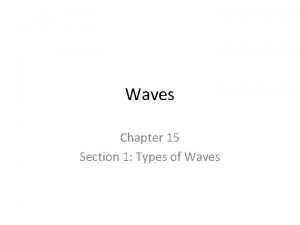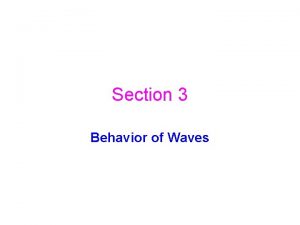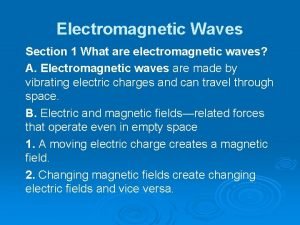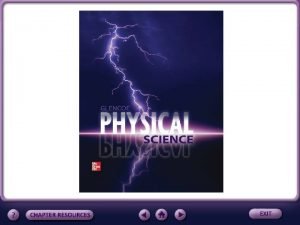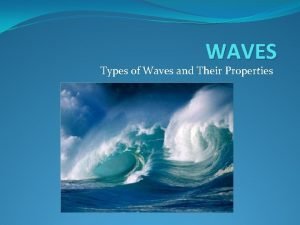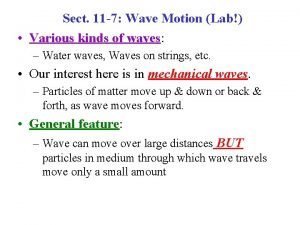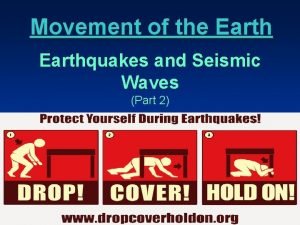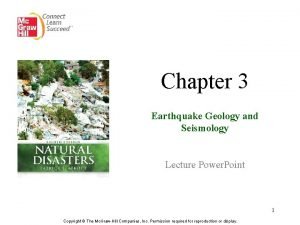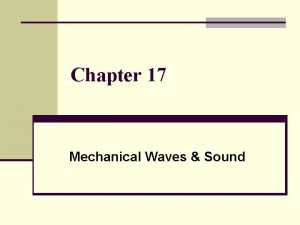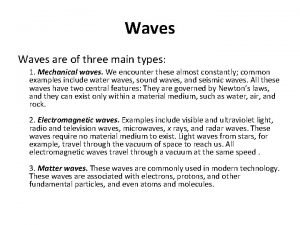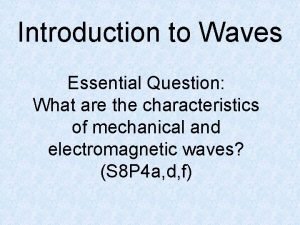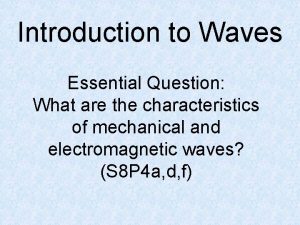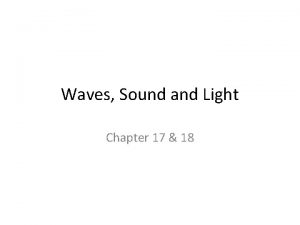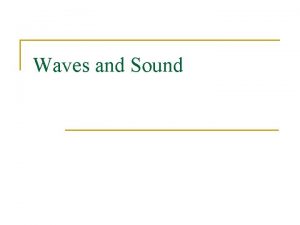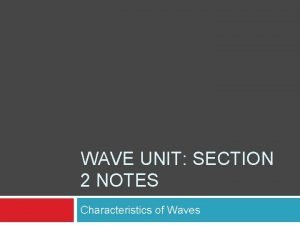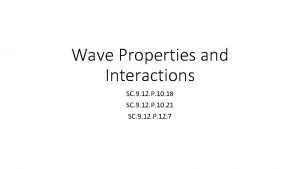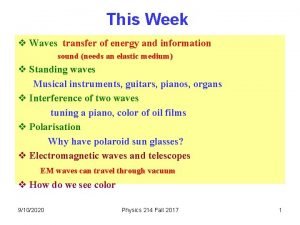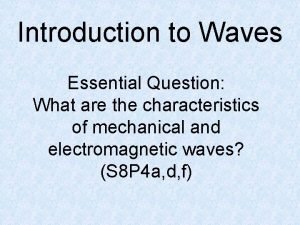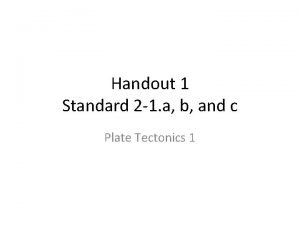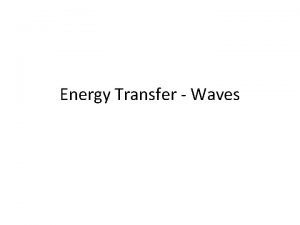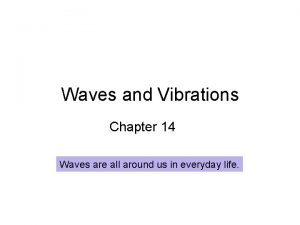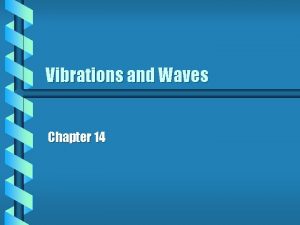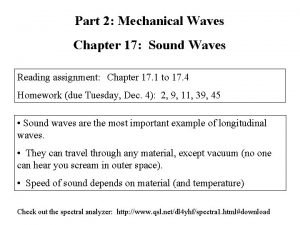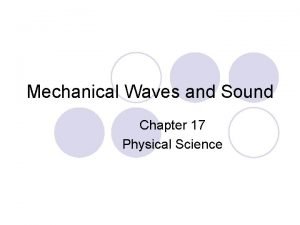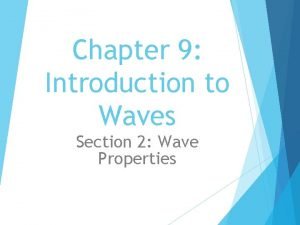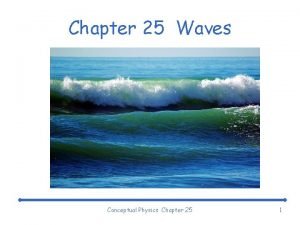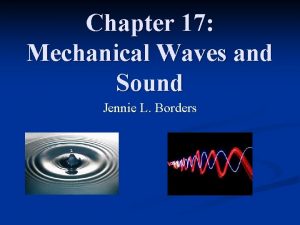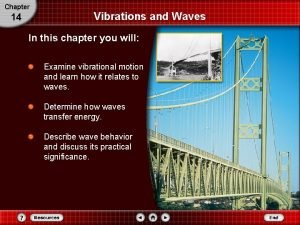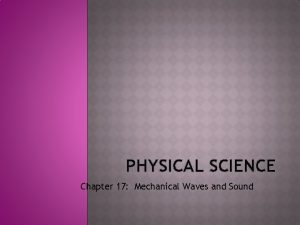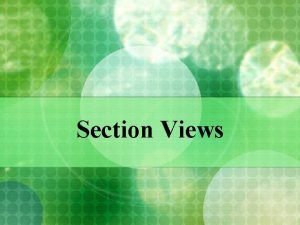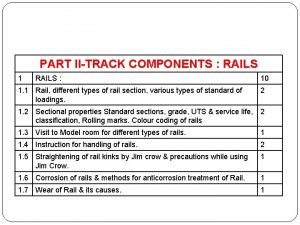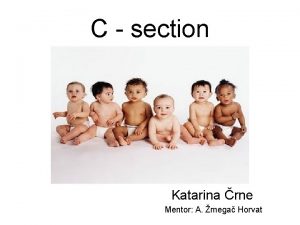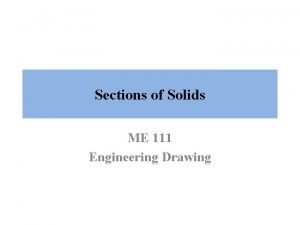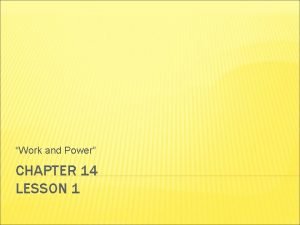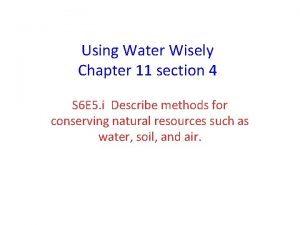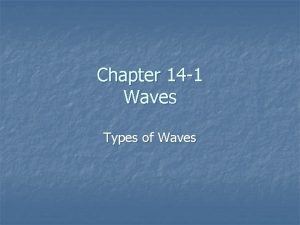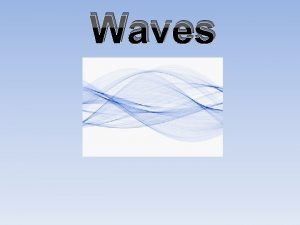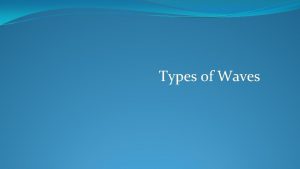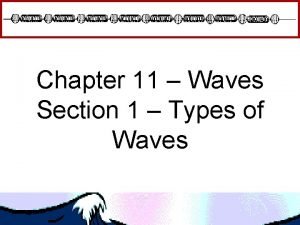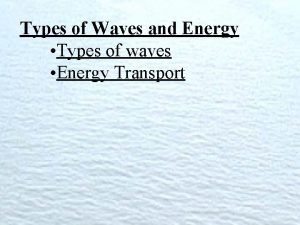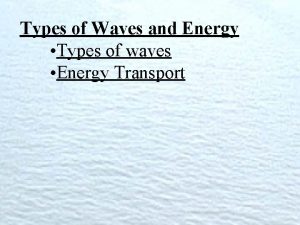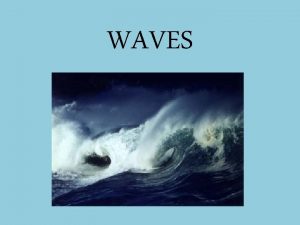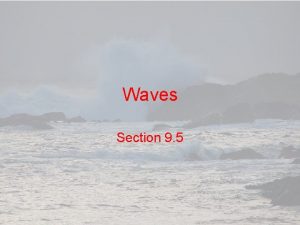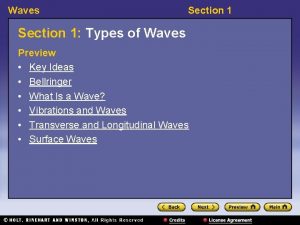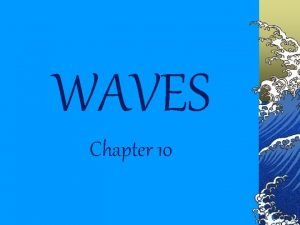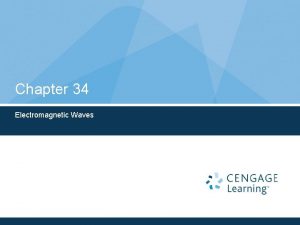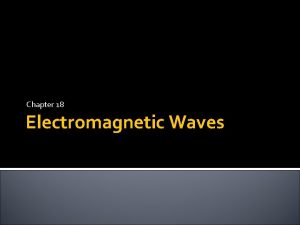Waves Chapter 15 Section 1 Types of Waves


































































- Slides: 66

Waves Chapter 15 Section 1: Types of Waves

What is a wave? • Wave- a movement of energy with no net movement of matter. – Like the wave done at a football game. – The fans stand up and sit back down, no net movement (they end up where the started). – Or a leaf floating on water • However, the wave itself actually moves around the stadium.

Medium • Mechanical waves require a substance to travel through. • Medium- any substance a wave can travel through. – Examples of mechanical waves include sound, water waves, or waves on a guitar string. – The plural of medium is media – Most waves are mechanical waves

No Medium • Electromagnetic waves are waves that can travel without a medium. – They consist of changing electric and magnetic fields in space • This means they can travel through outer space without a medium. • Examples of EM waves include radio waves, light, IR, and UV. – Although they do not require a medium they can travel through media if its there.

Waves transfer energy • Energy: ability to exert force over a distance (or to do work) – Waves can do work: like moving a boat on the water; sound waves work on your eardrum – Tsunamis carry a lot of energy • https: //www. youtube. com/watch? v=d. JBS 94 GVyuo

Energy may spread out as a wave travels……. • Being up front at a concert is more damaging to your hearing than being further away – Sound waves travel in spheres (like throwing a rock into a pond) – This is called a wave front • The closer you are to the origin of the sound, the smaller the wave front (smaller surface area but a large amount energy)

Vibrations and waves • When a singer sings: – the vocal cords move, – air moving through the throat vibrates – sound waves are created – causing the eardrum to vibrate – electrical impulses are sent to your brain – you hear sound

The mechanical energy of a vibrating mass-spring system changes form…. • Simple harmonic motion – Example: if a mass on a string moves up and down; there are times when the mass returns to its original resting position; this bouncing up and down is simple harmonic motion

A wave can pass through a series of vibrating • Damped harmonic motion: a vibration that fades out as energy is transferred from one object to another

Transverse Waves • Transverse wave- the particles of the medium vibrate perpendicular to the direction the wave is traveling. (electromagnetic waves are an example) • Like a wave on a string – The waves go this way – But the string vibrates this way • The top of the wave is the crest, the bottom is the trough • http: //www. pbslearningmedia. org/resource/psu 10 phy. sci. trans waves/transverse-waves/ Crest Trough

Longitudinal Waves • Longitudinal Waves- the particles of the medium vibrate parallel to the direction the wave is moving. – Sound waves are longitudinal waves • When the particles are compressed together is called a compression. • If they are spread out it is a rarefaction.


Surface wave • Surface Waves- waves occurring at the boundary of two media that combine both transverse and longitudinal waves. – The surface of water does this. – The air is longitudinal, the water underneath is transverse. • The surface wave will have water molecules moving in a circle.

Characteristics of Waves Section 2

Measurable qualities of waves • Amplitude and wavelength are measurements of distance – Amplitude- the height of the wave (compared to the original resting position); measures the amount of particle vibration • The larger the amplitude of the wave, the more energy it has. • Wavelength- The distance between two crests or two troughs of a wave

Waves parts crest wavelength Amplitude (from resting to Crest or resting to trough) trough Longitudinal Wavelength compression rarefaction

Amplitude and wavelength tell you about energy • The larger the amplitude, the more energy • The shorter the wavelength the more energy

Period • Period (T)- time it takes to complete one full cycle, for one wave to pass (best measured from crest to crest or trough to trough) the units are seconds – Lay mans terms: the number of seconds between two successive wave crests (two “ups”, or two “downs”)


Frequency • Frequency (f)- number of cycles or waves per second, units are hertz (Hz) – T = 1/f – Example on right: Same amount of time, but different number of “cycles”

Wave Equation • Wave speed (v)- the rate of travel of a wave, units are m/s • You can calculate the wave speed by multiplying the frequency (f) by the wavelength ( ) • The units for wavelength are meters (m) – v = f

Wave speed depends on the medium • Sound waves: travel fast through air but faster through water, fastest in solids • Speed of the wave depends on the medium – In a “given” medium, you cannot alter the speed, but you can change the frequency and wavelength

Kinetic Theory explains differences in wave speed • Remember: solids, liquids, gases are constructed differently – The more molecules the better the movement of the wave

Light has a finite speed • This means light can only go so fast Speed of light: this is a constant value through empty space this is 3. 00 x 108 m/s (or 186, 000 miles/second) Denoted as “c”

The Doppler Effect • Motion between the source of waves and the observer creates a change in observed frequency – You’ve experienced this with an ambulance passing by etc

Pitch is determined by the freqency of sound waves • Pitch- how high or how low a sound is – Determined by frequency (how fast the vibrations travel) Frequency changes when the source of waves is moving the closer the noise making object is, the more frequent; the further away the less frequent the wave

Wave Interactions Section 3

When waves hit something. . • When a wave comes into contact with a different medium (like air to water, air to glass etc) – it can be reflected (bounced back), – pass through the object or be absorbed – converted to another form of energy by the object. • Normally it does some measure of all 3

Reflection • The bouncing back of a wave when it meets a surface or boundary

Waves passing through • Refraction- wave passing from one medium to another and bending or changing its path when it does. – This is why your straw looks crooked in a glass of water, or your legs look broken in a pool.

• Diffraction- wave spreading out as it goes through an opening

Diagrams Refraction Diffraction

Wave Interactions • What happens when two waves collide with one another? • They will pass through each other unaffected by the collision. • Superposition- two waves can occupy the same space at the same time, when this is happening we say the two waves are interfering with one another.

Interference (superposition) • When several waves are in the same location they will combine and produce a new single wave – The wave will be different that the original waves • Constructive interference- increases the amplitude – If the crest of one wave, overlaps the crest of another wave- THEY ADD •


Constructive Interference Before Interference Where the crests meet their Amplitude adds After they pass through Each other the waves Continue as normal

• Destructive interference- when the crest of one wave meets the trough of another wave – The amplitudes substract from each other – The wave produced has a smaller amplitude

For a transverse wave traveling on a rope tied to something… • If the end is fixed (cannot move) the wave will be inverted (or flipped upside down) when it is reflected

Fixed end Newton’s 3 rd Law The rope pulls up on the end. The end pushes the rope down

If the end is loose (the rope can slide up and down) the wave will be reflected exactly as it came in.

Loose end Since the rope can slide, it never Pulls up on the end.

Destructive Interference Before Interference After

Interference of light waves create colorful displays • When light waves bounce off a bubble, some waves bounce right back, some waves go through • Either way the colors you see are determined by the interference of the waves

Standing Wave • If we get a wave on a string with a fixed end at the appropriate frequency we can create a Standing Wave • ~A wave that looks like its standing still

Terminology • Nodes- points on the standing wave where there is no vibration. – There is maximum destructive interference at this point. • Antinodes- points on a standing wave with the most vibration. – There is maximum constructive interference at this point.

Standing Wave Antinode Node

What this means to music • Standing waves are extremely important in music. – By stopping vibration at certain points (antinodes), you can change the wavelength. – This changes the frequency or pitch. • So when you put your finger on a guitar chord or a flute and you make it play a different note. • Other instruments also change the length of the standing wave (trombone)

Chapter 16 Section 2 The Nature of Light

Waves and particles • The two most common models describe light either as a wave or as a stream of particles – Light produces interference patterns too

Light as a wave • Shown by Thomas Young – Acts like a transverse wave, has amplitude, frequency and wavelength – Doesn’t require a medium – Light waves are also called electromagnetic waves because they consist of changing electric and magnetic fields

The wave model can’t explain some observations • Very bright red light has more energy than dim blue light – The bright light has higher amplitude than the dimmer blue light – The blue light can knock electrons through metal but the red cant----the wave model couldn’t explain this

Light can be modeled as a stream of particles • if light carries particles (photons) then this can account for the electrons bouncing off the metal plate – Photons do not have mass, but they are like little bundles of energy that are located in a specific area

Waves vs particles • Can be shown correct depending on the experiment! – Both models are currently accepted – Light is considered to have a dual nature

Characteristics of light • Energy of light is proportional to frequency • The speed of light depends on the medium • The brightness of light depends on intensity – The number of photons per second (or power) that passes through a certain area of space

The electromagnetic spectrum • Consists of waves at all possible energies, frequencies, and wavelengths (not all that are visible to us)

Radiowaves • Radio waves: the longest waves in the spectrum (measured in tenths of a meter to thousands of meters) – TV signals, radio signals – Radar: a system that uses radio waves to find the locations of objects • The waves bounce off the object and return to a receiver • Airplanes use this, policemen

Microwaves • Used in cooking and communication • Wavelengths in range of centimeters – Reflected by metals, transmitted through air, glass, paper and plastic – The water, fat and sugar in foods absorb microwaves

Infrared light • Can be felt as warmth • Slightly longer wavelengths of red visible light – From the sun – Used to warm food at restaurants – Used in sensors to measure heat energy

Ultraviolet light • Invisible light that lies just beyond violet light – Higher energy and shorter wavelengths than visible light – Many insects can see but not humans

X rays and gamma rays • X rays – Higher energy and shorter wavelengths than UV waves Gamma rays EM waves with the highest energy and have very short wavelengths Used in medicine

Chapter 16 section 3 Reflection and color

Reflection of light • Every object reflects some light and absorbs some light – How light is reflected/absorbed depends on the surface of the object Rough surfaces: light reflects in many directions : diffuse reflection

Ø Smooth surfaces reflect in one direction Angle of incidence: the angle at which the light hits the surface Ø Angle of reflection: the angle of light rays reflecting off the surface Ø Ø Law of reflection: (the equality of the two above angles) the angle of incidence equals the angle of reflection (measured from the normal)

mirrors • Reflect light as described by the law of reflection – The type of image that is received depends on the type of mirror – Flat mirrors form virtual images by reflection • The virtual image appears to be as far behind the mirror as you are in front of the mirror

Curved mirrors • Distort images – Convex mirrors curve out (like side mirrors on the car) and make the images appear smaller – Concave mirrors curve in: some magnify objects

Seeing colors • The colors that you perceive depend on the wavelengths of visible light that reach your eyes – Like a leaf: it only reflects light, doesn’t emit light Objects have the color of the wavelengths they reflect Mixtures of colors produce other colors
 Chapter 15 section 1 types of waves answers
Chapter 15 section 1 types of waves answers The wave chapter 10
The wave chapter 10 Similarities of mechanical waves and electromagnetic waves
Similarities of mechanical waves and electromagnetic waves Electromagnetic waves are longitudinal waves true or false
Electromagnetic waves are longitudinal waves true or false Example mechanical waves
Example mechanical waves Mechanical and electromagnetic waves similarities
Mechanical and electromagnetic waves similarities Characteristics of a longitudinal wave
Characteristics of a longitudinal wave Sound waves longitudinal waves
Sound waves longitudinal waves Carbon dioxide temperature
Carbon dioxide temperature Difference between matter waves and electromagnetic waves
Difference between matter waves and electromagnetic waves Mechanical vs electromagnetic waves
Mechanical vs electromagnetic waves Mechanical waves and electromagnetic waves similarities
Mechanical waves and electromagnetic waves similarities Surface waves and body waves
Surface waves and body waves Seismic waves are mechanical waves
Seismic waves are mechanical waves Compare and contrast p waves and s waves using venn diagram
Compare and contrast p waves and s waves using venn diagram Mechanical and electromagnetic waves
Mechanical and electromagnetic waves Aimtoknow
Aimtoknow Chapter 10 section 1 meiosis worksheet answer key
Chapter 10 section 1 meiosis worksheet answer key Chapter 9 section 2 types of interest groups
Chapter 9 section 2 types of interest groups The behavior of waves section 3
The behavior of waves section 3 Section 1 what are electromagnetic waves
Section 1 what are electromagnetic waves Section 1 what are electromagnetic waves
Section 1 what are electromagnetic waves Wave types
Wave types What kind of wave is this
What kind of wave is this Seismic wave types
Seismic wave types Two types of body waves
Two types of body waves Two types of body waves
Two types of body waves Two types of body waves
Two types of body waves Chapter 17 mechanical waves and sound
Chapter 17 mechanical waves and sound Fm vs am
Fm vs am Parts of a wavelength
Parts of a wavelength Types of waves quad clusters answer key
Types of waves quad clusters answer key Different types of mechanical waves
Different types of mechanical waves What are the two types of waves?
What are the two types of waves? Wave speed examples
Wave speed examples What are the two types of waves?
What are the two types of waves? What are the two types of waves?
What are the two types of waves? Types of waves quad clusters
Types of waves quad clusters Seismic waves
Seismic waves What transmits energy without transferring matter
What transmits energy without transferring matter Four types of seismic waves
Four types of seismic waves Chapter 14 vibrations and waves
Chapter 14 vibrations and waves Chapter 14 vibrations and waves
Chapter 14 vibrations and waves Chapter 17 mechanical waves and sound wordwise answer key
Chapter 17 mechanical waves and sound wordwise answer key Which travels along a surface separating two media
Which travels along a surface separating two media Chapter 9 introduction to waves
Chapter 9 introduction to waves Bow wave aircraft
Bow wave aircraft Mechanical waves and sound
Mechanical waves and sound Chapter 14 vibrations and waves
Chapter 14 vibrations and waves Chapter 17 mechanical waves and sound
Chapter 17 mechanical waves and sound Half sectional view
Half sectional view Revolved section
Revolved section Section view examples
Section view examples Section 2 describing energy (continued)
Section 2 describing energy (continued) Health education for lscs mother
Health education for lscs mother Section view types
Section view types Double headed rails
Double headed rails C section type
C section type Sectional view engineering drawing
Sectional view engineering drawing Chapter 17 section 3 world history
Chapter 17 section 3 world history Chapter 30 section 2 world history
Chapter 30 section 2 world history Chapter 15 section 2 world history
Chapter 15 section 2 world history Chapter 10 section 2 central america and the caribbean
Chapter 10 section 2 central america and the caribbean Unit 14 lesson 1 drivers ed
Unit 14 lesson 1 drivers ed Chapter 19 section 4 wilson fights for peace
Chapter 19 section 4 wilson fights for peace Chapter 24 section 2 watergate answers
Chapter 24 section 2 watergate answers Chapter 11 section 4 using water wisely answer key
Chapter 11 section 4 using water wisely answer key
